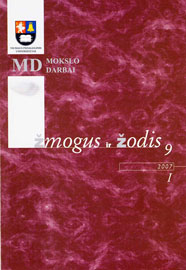Mokomųjų tekstų sakinio ilgis ir struktūra
Sentence Length and Structure in Educational Texts
Author(s): Audronė BitinienėSubject(s): Language and Literature Studies
Published by: Vytauto Didžiojo Universitetas
Keywords: educational texts; sentence length; sentence structure
Summary/Abstract: The article deals with sentence length and structure peculiarities in educational texts for secondary schools. The research is based on the data obtained from a stratified sample of 3100 sentences and processed using statistical data analysis. It was distinguished that the low sentence length average (12.1 words) and the sentence length paradigm could be predetermined by the tendency of sentence segmentation. It is the most important linguistic feature of educational texts indicating an objective to reduce the information load of a single sentence. On the other hand, segmentation of sentences may result in one third of the text being constituted of independent sentence linking devices, thus creating certain redundancy of means of expression. Sentence segmentation could be called the dominant of such texts. The research indicates average differentiation in texts of the said sub-style. Very short 1-8 word sentences (48.3 per cent) dominate in educational texts intended for 5th-6th form learners. Meanvvhile, texts for the seventh and above forms mostly contain short 9-17 word sentences (54.4 per cent). Grammatically, the majority of the educational texts are written in simple sentences. Ali of the sentence length and structure parameters reflect a contrast with those used in higher school educational texts, where very short sentences (1-8 words) are twice as scarce, and medium length sentences (18-30 words) are twice as abundant. The above peculiarity and other syntactical textual features indicate that educational texts used at secondary schools, even in senior school years, are substantially different from higher school educational texts. This could mean that a distinctive syntactical expression of educational texts has formed, influenced by extralinguistic and linguistic factors, especially overbalance of description in texts
Journal: Žmogus ir žodis
- Issue Year: 09/2007
- Issue No: 1
- Page Range: 12-18
- Page Count: 7
- Language: Lithuanian

